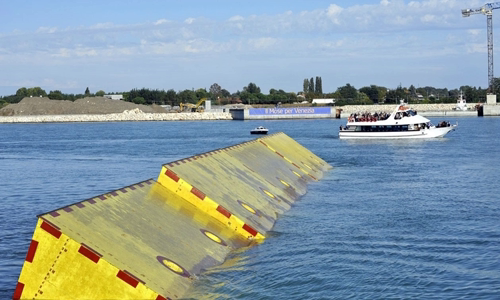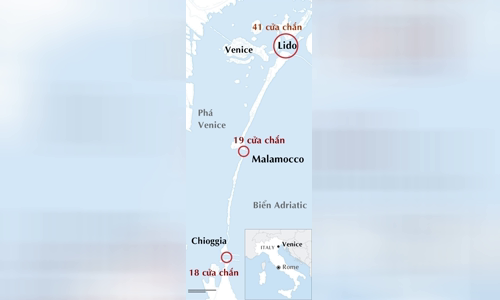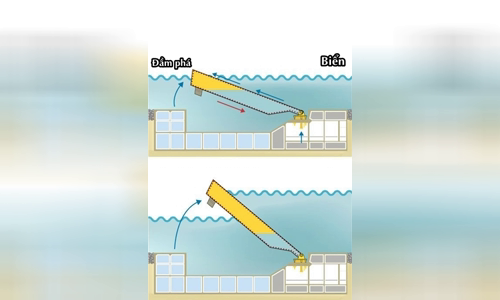As water rose in the lagoon of Venice, Chioggia's mayor Alessandro Ferro wanted to use the flood gates of billions of dollars but failed.
On November 12, Venice, Chioggia and the surrounding islands at Venice lagoon (enclosed bay located on the Adriatic Sea, where the city of Venice is located) suffered the worst flood in more than half a century, rising water more than 1.8 m.

The dam system was tested in October 2013 Photo: AP
The barrier system proposed by Ferro has been tested but not yet in operation. It remained on the ocean floor when about 80% of Venice was submerged in water, causing an estimated damage of one billion EUR (US $ 1.11 billion). Brackish water has entered the tomb of St. Mark's church since the 12th century.
"I feel bitter and frustrated. It's risky but worth a try," Ferro said. "If it works then we will be dry."
The reason the system is not being used is a story of corruption, bureaucracy and distrust of the public.
Italy began its efforts to protect Venice after 1966, when the city suffered one of the worst floods in history. By the 1980s, the central and local governments agreed on a solution: to build a floodgate system that could be raised and lowered at three ways to the Adriatic Sea of the lagoon of Venice.
Gate system at three entrances to the Adriatic Sea of lagoon Venice. Graphics: WSJ.
Flood gates will be under the sea when not used to avoid the structure affecting the environment and aesthetics. They are raised during high tide. The system, called MOSE (Experimental Electromechanical Module), is similar to the name of Moses, the prophet who turned the Red Sea to save the people according to the Bible.
Venice does not need a miracle. Rotterdam, London and other cities have successfully installed retractable barrier gates at the river mouths.
In 2003, the construction was just started because the design needed approval from more than a dozen public agencies, expert panels and courts. The government allocated EUR 1.7 billion for the project, a private construction company with a goal of completion by 2012.
But many problems arose that were behind schedule. In 2014, a corruption scandal forced the government to control the project when it was 80% complete. In 2015, the hinge to raise and lower the door began to show signs of rust. Engineers recognized the problem of metals early on, but due to bureaucratic approval, it was impossible to quickly switch to other materials. The dehumidifier system that should have been installed has not been implemented yet.

Dam system at three entrances to the Adriatic Sea of lagoon of Venice Photo: WSJ
MOSE is currently about 93% complete and is expected to be operational by the end of 2021. The cost has increased to EUR 5.5 billion.
On 12/11, the tide in Venice rose to 187 cm, the highest level since 1966 and far exceeded the official forecast given only a few hours earlier. Strong winds have pushed more water from the sea into the lagoon than expected.
Store owners and residents use planks to seal the ground floor and windows. Some people write the MOSE on their homemade "beats" at home to make irony. Water also seeps into buildings through toilets, sinks, and electrical pipes. The stench of sewage filled Venice's gothic alleys and Renaissance castles.
Andrea Sandi, co-owner of the restaurant on the banks of the Paradiso Perduto Canal, tries to save things. In the kitchen, the dishwasher, the fridge and the fryer were submerged in the sea rising to his thighs. "If we have an effective dam then it will save us," Sandi said. He estimated flooding caused the restaurant to lose 50,000 euros.
Like many Venetian people, Mr. Sandi doubted the effectiveness of MOSE. "I think MOSE is a utopian project. Its only use is to help the greedy officials," he said. "We want the dam to be able to 'dive' into the water. That would make the landscape more beautiful, but would it be useful?"
MOSE includes 78 mobile ports, each weighing 330 tons. These ports are filled with water when not in use. At high tide, compressed air is pumped to push the water out, the gates lift until they rise above the water and face towards the Adriatic Sea.
During high tide, the gates will be raised to block the water. Graphics: WSJ.
MOSE supporters say mobility is the creative point of the building, and problems during construction are normal for such a large and complex project. "With the tests we have done, there is no sign that MOSE will not be useful," said Alessandro Soru, MOSE project manager.
However, hydraulic engineer Luigi D'Alpaos, who has spent years researching how to protect Venice, thinks that setting up and lowering the system is the key to the project's failure. "Operation and maintenance costs will be huge," D'Alpaos said. "However, we cannot turn back now, so the project needs to be completed."

During high tide, the dam will be lifted to stop the current Photo: WSJ
A few days before the November 12 flood, Mayor Ferro was worried when he saw an unusual tide forecast. He wanted to deploy the barrier system but he didn't know who to call because it was unclear who was responsible. The Italian government has not decided which party will operate the system.
Engineers say the system is not ready. Some pneumatic pumps have not been installed. Previous trials were successful, but they were only increasing the number of ports. MOSE has never been tested during high tide. Engineers warn that the incomplete implementation of the barrier could flood submerged tunnels, damage the system and threaten workers' lives.
The system is designed to block tides up to 300 cm. If the gates were raised and functioning as intended, Venice would dry out. But it is unclear how long it can protect Venice, because it is designed based on the assumption that sea level will rise less than current forecast.
The project is designed to last 100 years with an average sea level rise of 60 cm. However, the UN Intergovernmental Panel on Climate Change says sea levels could rise to 110 cm by the end of this century.
"In the best case scenario, MOSE protects us for 100 years, the worst case is 50 years," said Giovanni Cecconi, an engineer who worked on the project.
For many Venetian people, if MOSE is useful, it will have an impact on whether they go or stay. The population of the city has been declining continuously for decades, partly due to more frequent flooding. There were 171,000 people living along the canals, now there are only 50,000.
"I love my city. I don't want to leave unless things really turn out to be unpredictable," said Antonio Dantelli, a 62-year-old resident of Venice.
On a recent rainy morning, Dantelli wore thigh-high rubber boots, walking out onto the street to see the sight of the city deserted by tourists. "Previously, water rarely rose to 140 cm. Now, it rises to 180 cm. What will we do in 10 years?".



 BethMarieHerrera
BethMarieHerrera







